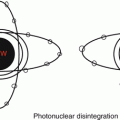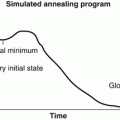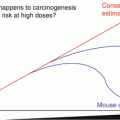, Foster D. Lasley2, Indra J. Das2, Marc S. Mendonca2 and Joseph R. Dynlacht2
(1)
Department of Radiation Oncology, CHRISTUS St. Patrick Regional Cancer Center, Lake Charles, LA, USA
(2)
Department of Radiation Oncology, Indiana University School of Medicine, Indianapolis, IN, USA
A Note on Nucleic Acids (DNA)
As a radiation biology text, this book focuses mostly on DNA and genes.
Information flows DNA → RNA → protein. This can also be described as gene → transcript → gene product.
DNA is composed of sugars, phosphates, and bases. The bases carry the information (code).
Purines (A, G) pair with pyrimidines (T, C).
Purines are large while pyrimidines are small.
“Big man, small name.”
DNA is wrapped around histones to form chromatin. Chromatin is the basic building block of chromosomes.
When talking about “single strand”, “double strand”, “chromatid”, and “chromosome” it is easy to become confused because so many structures come in pairs (Fig. 17.1):
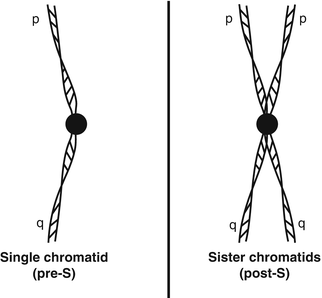
Fig. 17.1
A chromosome may contain one or two copies of each chromatid, but DNA is always double stranded.
Unreplicated chromosomes (Pre-S) exist as a p- and q- chromatid, with no sister chromatids.
Because humans are diploid, there are two of each chromosome.
However, unless you are a clone your two Chromosome 4′s are different from each other: One comes from your mom, the other comes from your dad.
Replicated chromosomes (Post-S) exist as identical sister chromatids, bound together by a centromere.
You still only have one maternal chromosome 4 and one paternal 4, but each one has 2 p-arms and 2 q-arms.
We are used to seeing replicated chromosomes because only M–phase chromosomes are visible on traditional karyotype (light microscopy) (Fig. 17.2).

Fig. 17.2
DNA in a (partial) karyotype. Most of the cells in our body are not in M phase, and do not have condensed chromosomes visible.
A Note on Gene Function
There are several ways to change the function of a gene. You can change the gene itself (mutation), you can change gene function without altering the gene (epigenetic change), or you can change the function of the gene product (protein).
Mutation is pretty straightforward: The DNA is different so it behaves differently.
Epigenetic changes are changes in gene function that do not alter the gene itself.
Gene Expression: Changes in the amount of mRNA transcribed from the gene.
Splice Variants: Changes in which parts of the gene are included in the final mRNA.
Point Mutations and Chromosomal Mutations
Mutations may be classified by size:
Point mutations: 1 to a few bp in size.
Gross mutations (thousands to millions of bp).
Aneuploidy (whole chromosomes, tens to hundreds of millions of bp)
Point mutations affect one or a few base pairs.
Single nucleotide mutations are also called single nucleotide polymorphisms (SNP) (Fig. 17.3):
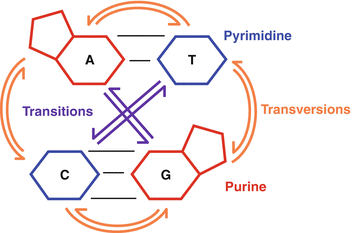
Fig. 17.3
Point mutations are classified as transitions (purine to purine or pyrimidine to pyrimidine) and transversions (purine to pyrimidine).
Mutations in coding regions are classified as silent, missense or nonsense mutations (Fig. 17.4):
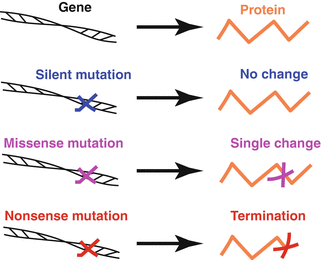
Fig. 17.4
Point mutations in a coding region of a gene may also be classified based on the change in the protein (gene product).
Mutations in non-coding regions may affect the expression and splicing of coding regions, but they are not as easy to describe.
Small Insertions and Deletions (a few base pairs) also count as point mutations.
These occur when DNA replication “stutters” and either skips or repeats a sequence.
Chromosomal Mutations (aka gross mutations) are large enough to affect the structure of an entire chromosome, generally millions of base pairs in length.
Gross deletions occur when pieces of DNA break off of the chromosome and are permanently lost.
Translocations occur when broken DNA sequences are re-attached to the wrong chromosome.
Amplifications occur when a DNA sequence is replicated multiple times in the same cell cycle.
Aneuploidy is the loss or gain of entire chromosomes.
The normal human cell has two pairs of chromosomes 1–22 and two sex chromosomes (X, Y male or X, X female) i.e. 46XX or 46XY
Stay updated, free articles. Join our Telegram channel

Full access? Get Clinical Tree



